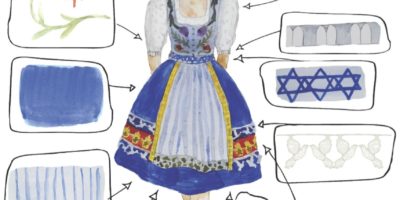The Idioms of Jewish Dress: Buttons, Wigs & Gartels
In the 17th century, European authorities initiated the slow repeal of mandatory Jewish dress codes. Vienna annulled its regulations in 1624, followed by Mannheim (1691), Austria (1781), Rome (1798), Prussia (1812), and elsewhere. For the first time in five centuries, Jews could legally dress like everybody else. Especially after the French Revolution, ideals such as equality and self-determination made it increasingly difficult to marginalize Jews simply on the basis of their Jewishness.
Historically, French law assigned old-fashioned yellow hats to Jews; everybody else wore black caps. But during an April 1790 festival, the Jews of Avignon, flush with the revolutionary promise of Liberté, Egalité, Fraternité, donned black hats to dance with their Gentile compatriots — themselves clad in yellow caps. Shortly thereafter, local Jews demanded permission to unlock the ghetto gates at night and to permanently doff the yellow chapeaux they had endured for centuries. One year later, the Jews of Avignon finally received their just prize: citizenship. They could now enjoy the black hat so symbolic of French fashion and equality.
The situation proved rather more ironic, though, at the nearby enclave of Comtat Venaissin. When the regional assembly in October 1790 untied Jews from yellow hats, the local populace rioted. Some Jews, fearful for the lives, requested the revival of the old dress code. In the city of Carpentras, Jews refused to swap their yellow hats lest they contravene biblical and rabbinic law by emulating Gentiles. The cap that for so long derided Jews now served, by their own choosing, to define them.
By the end of the 19th century, imperial Russian decrees targeted all manner of stereotypical Jewish dress, including silk hoods, fur hats, short trousers, and sashes. Jewish women, declared one edict, “should wear simple garments, similar to what Russian women wear. Without question, they are forbidden to wear wigs of any sort that match their hair color.” Only the elderly received exemptions.
Many Jews did change “their national costume,” as one Russian official reported in 1845, but other Jews saw the new restrictions as an outright assault on Judaism. “Our traditional costume,” reports one memoir (Pauline Wengeroff’s Rememberings: The World of a Russian-Jewish Woman in the 19th Century), “was mourned like a beloved departed person.” Some Jews refused to leave their homes. They wept, prayed, and fasted.
Similar events unfolded in the Polish territories, partly to foster Jewish assimilation, partly to revive the national textile industry. Edicts prohibited Jewish men from appearing in long beards, ear-locks, silk and woolen cloaks, broad gartel belts (“meant to protect the purity of the mind from lower body carnality and pollution”), fur hats, short trousers with stockings, and old-fashioned caps lacking a modern peak.
Jewish women were similarly told to dispense with their turbans, “Jewish cut” dresses, colored shoes, and characteristic ornaments. With the exception of the home and synagogue, Jews would henceforth appear like other citizens.
A modern dress code for Jews, proclaimed the Duchy of Warsaw, would assist “the progress of civilization of that people.” As incentive, the territory granted properly attired Jews special residential and occupational privileges. But most Jews could afford to pay for neither a new outfit nor an exemption tariff, and so they were beaten, forcefully shorn, and sometimes imprisoned.
Ironically, edicts demanding assimilation actually fostered a self-conscious sense of Jewishness, especially among educated and urban Jews who otherwise tethered their identity to modernist aspirations. Many Jews, too, responded to these revised dress codes by investing their garments with deep emotional and religious significance.
Clothing merely worn by Jews now became seen as traditional Jewish clothing, symbolizing traditional Jewish values. For example, the norm in modern male fashion is to button coats and shirts left over right. But Hasidic men, like modern women, button right over left. These conventions undoubtedly arose through happenstance. Nonetheless, Hasidic men came to see their buttons as symbolizing the triumph of divine mercy and goodness, which the medieval mystics associated with the right side of the body, over the harsh judgment and demonic powers of the left side. Jews who button in a modern fashion, declared Rabbi Menachem Mendel from Rimanov, walk in the ways of idolaters.
State-sponsored efforts to assimilate Jews transformed certain garments from mere custom into a religious obligation. Modernity tailored tradition.
Adapted from A Cultural History of Jewish Dress (Bloomsbury Academic, 2013).


